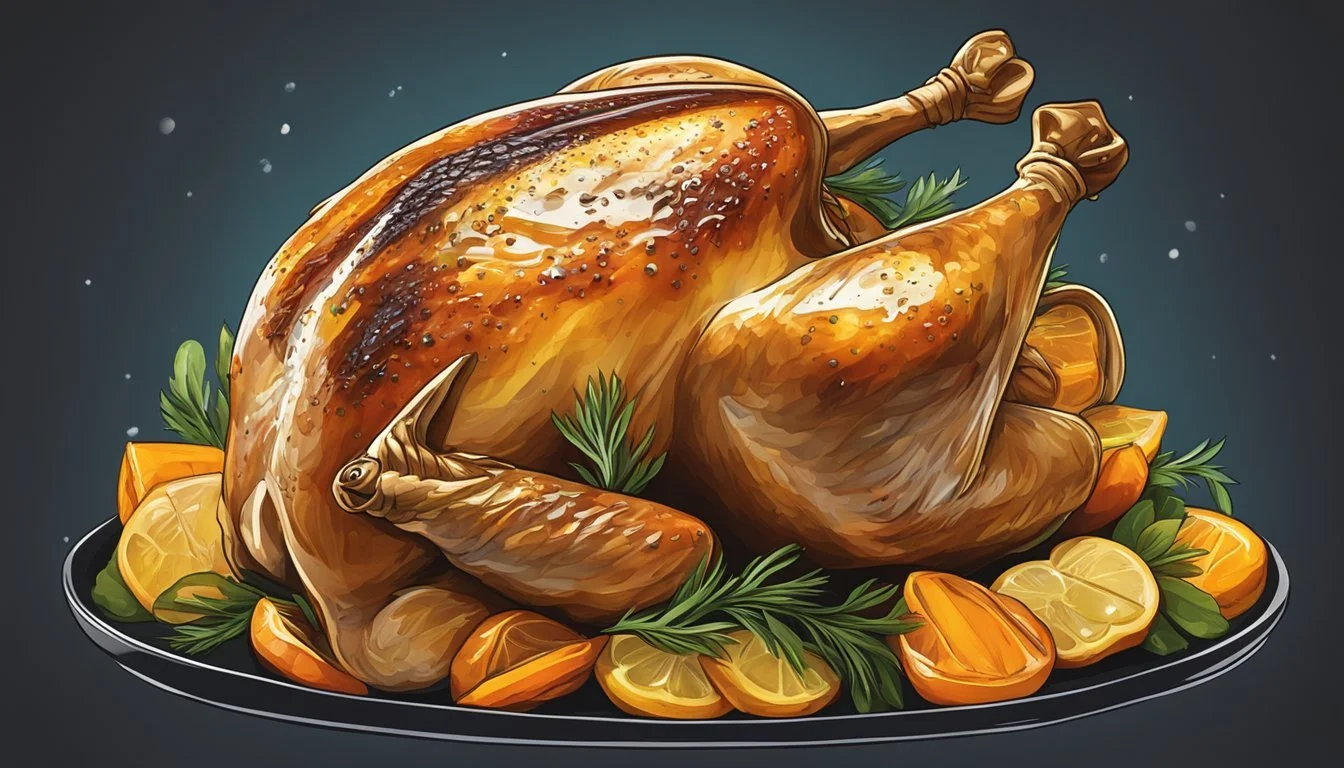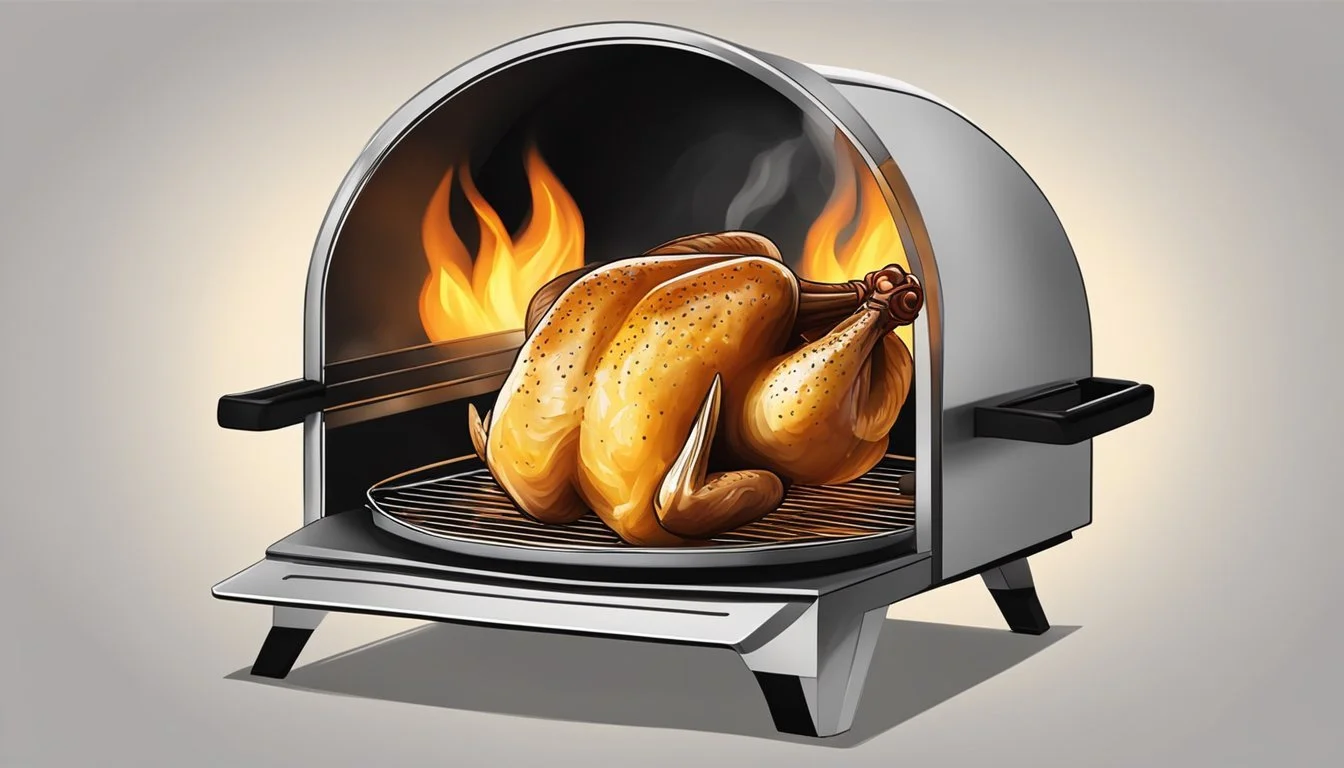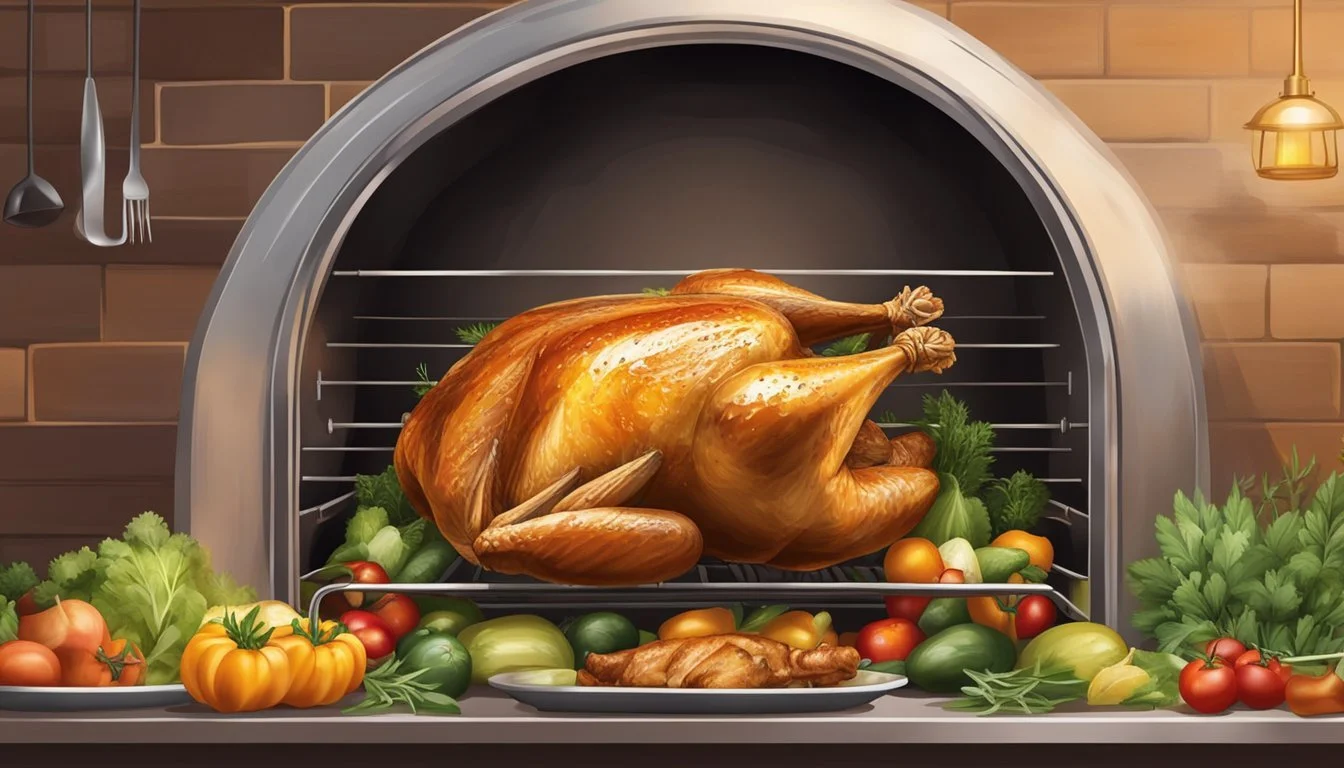The Faux Rotisserie Chicken
Mastering Spit-Style Oven Roasting
The faux rotisserie chicken offers a homemade twist on the classic rotisserie cooking method, bringing the slow-roasted, evenly cooked, and scrumptiously seasoned bird straight from the oven to the dining table. This culinary technique mimics the traditional rotisserie roasting by using a home oven, ensuring that even those without a rotisserie spit can still enjoy chicken with a delightfully crispy exterior and moist interior. It involves a preparation process that allows the chicken to be seasoned thoroughly, which might include a dry rub or a buttery marinade, ensuring that each bite is infused with flavor.
To achieve the signature rotisserie-style cooking without the spit, cooks employ their ovens and a roasting pan setup that allows heat to circulate freely around the chicken, much like it would in a rotisserie oven. This could involve a wire rack set in a sheet pan or a specialized roasting pan designed to hold the chicken above the pan's base. The result is remarkably similar to a rotisserie chicken, with a perfect golden-brown skin and tender, juicy meat that separates effortlessly from the bone. Embarking on the process of making faux rotisserie chicken at home not only fills the kitchen with a mouth-watering aroma but also provides a sense of accomplishment when presenting a beautifully roasted bird to family and friends.
Preparation of the Chicken
The preparation of a faux rotisserie chicken begins with choosing the right bird and ends with applying the perfect blend of seasonings. These steps are crucial to achieving the desired flavor and texture that mimic the traditional rotisserie chicken.
Selecting the Right Chicken
When selecting a whole chicken for roasting, one should look for a bird that weighs approximately 4 to 5 pounds; this size ensures an even cooking experience. The chicken should feel firm to the touch, indicating freshness.
Cleaning and Trussing
Upon bringing the chicken home, it must be cleaned thoroughly. Begin by removing any giblets from inside the cavity and rinsing the chicken under cold water. After the rinse, it is imperative to pat the chicken dry with paper towels to remove excess moisture, which helps to achieve a crisp skin. Following drying, truss the chicken by tying the legs together and securing the wings to the body. This promotes even cooking and helps retain the bird's shape.
Applying the Rotisserie Chicken Seasoning
Creating the optimal seasoning blend is a pivotal step in the faux rotisserie process. Mix equal parts of salt, pepper, garlic powder, onion powder, dried thyme, and a pinch of cayenne pepper to incorporate a balance of flavors and subtle heat. Rub the chicken inside and out with olive oil or another high-heat oil to help the seasoning adhere. Then, evenly distribute the rotisserie chicken seasoning over the entire surface of the bird to ensure every bite is well-flavored.
Oven Setup and Roasting
To achieve a rotisserie-like roast chicken in the oven, one needs to understand the importance of oven setup and the roasting process. This ensures the chicken is evenly cooked to succulent perfection.
Preparing the Oven
The oven should be preheated to reach the optimal roasting temperature—usually between 300°F and 450°F, leveraging the variance for initial searing or slow roasting. Placement of racks is crucial; the lowest rack position is typically advised to emulate the heat dynamics of a rotisserie.
For initial searing: Preheat oven to 450°F.
For slow roasting: Lower the temperature to 300°F after the sear.
A baking sheet lined with foil, topped with a wire rack, creates airflow around the chicken, mimicking the rotisserie environment. This setup is essential for evenly cooked and browned skin.
Using a Makeshift Spit
While a traditional rotisserie uses a spit to rotate the chicken, one can improvise with a skillet or roasting pan fitted with a rack. The chicken should be positioned breast-side up to begin. Trussing the chicken beforehand helps maintain its shape and promotes even cooking.
Roasting the Chicken to Perfection
One must meticulously monitor the internal temperature using a thermometer to ensure the roasted chicken (What wine goes well with roasted chicken?) is cooked thoroughly without overcooking. The target temperature for doneness is an internal temperature of 165°F when measured at the thigh, not touching the bone.
Start with a high temperature to crisp the skin.
Lower the heat for slow-roasting to keep the juices in.
Basting occasionally with pan juices or a marinade further reinforces the rotisserie effect, adding moisture and flavor. Once finished, let the chicken rest before carving to redistribute the juices.
Health and Nutrition
The oven-roasted faux rotisserie chicken offers a substantial nutritional profile, providing essential macronutrients and a range of vitamins and minerals important for maintaining health.
Macronutrient Breakdown
Calories: A typical serving of roasted chicken without skin can contain approximately 165-200 calories, with variations depending on the size and specific part of the chicken.
Protein: This chicken is a rich source of lean protein, with about 25 grams per 3-ounce serving, crucial for muscle repair and growth.
Carbohydrates: Generally, roasted chicken contains minimal carbohydrates, as it is primarily a source of protein and fat.
Fat: Dark meat and skin add fat to the dish, with a thigh providing around 10 grams of fat, whereas skinless breast is lower in fat, with about 3 grams per serving.
Fiber: Chicken is not a source of fiber.
Vitamins and Minerals Content
Vitamin A:
Skin-on preparations may include more vitamin A.
Calcium:
Chicken is not a significant source of calcium, but it is usually consumed with other foods that may contribute to calcium intake.
Iron:
A good source of heme iron, which is easily absorbed by the body, especially found in the darker meat of the chicken.
Vitamin C:
Chicken by itself does not contain vitamin C, but can be paired with vitamin C-rich foods to boost absorption of iron.
Serving and Presentation
The moment of truth in the art of oven-roasted faux-rotisserie chicken is in its presentation, where the golden, crisp skin meets the perfectly carved slices. Presentation is not just about aesthetics; it enhances the dining experience with a feast for the eyes, complementing the tenderness and flavor that awaits.
Carving and Plating
To carve the roasted chicken, one should begin by removing the twine. Use a sharp carving knife to slice through the skin between the thigh and the body. Bend back the thigh to pop the joint out of the socket, and cut through the joint to remove the thigh and leg. Repeat on the other side. Then, cut downward along one side of the breastbone, following the bone's contour with the knife, and gently slice the breast meat away. Repeat on the opposite side to remove both breasts. One can then slice the breast meat across the grain for more tenderness. Plate the chicken with the skin side up to showcase its crispy texture.
Thighs and Legs: Remove first for those who prefer darker, juicier meat.
Breasts: Sliced against the grain, ensuring every piece is tender.
Suggested Accompaniments
The ideal accompaniment should complement the chicken's flavorful profile.
Sauces: Enhance the dish with a simple jus made from the chicken's cooking juices or a herb-infused gravy.
Potatoes: Offer a side of roasted potatoes, seasoned with the same spices used on the chicken for a cohesive taste.
Vegetables: Steamed or roasted vegetables, such as carrots or green beans, add color and lightness to the plate, balancing the richness of the chicken.
Roasted chicken is versatile, pairing well with various sides to elevate the overall meal.
Recipes Utilizing Leftover Chicken
Leftover chicken, whether it's from a faux rotisserie chicken or actual leftovers, can be a versatile ingredient in a variety of dishes. The flexibility of chicken allows it to be incorporated into a range of recipes that can be light and refreshing or rich and comforting.
Salads and Light Meals
Leftover chicken is perfect for incorporating into salads and light meals. For a refreshing Chicken Salad, one can mix diced chicken breast (What wine goes well with chicken breast?) with a combination of mayonnaise, mustard, chopped celery, onions, and herbs. Serve this on a bed of greens or in a sandwich for a quick lunch.
Quesadillas make for another great light meal, with shredded chicken thighs (What wine goes well with chicken thighs?) combining well with cheese, peppers, and taco seasoning between two tortillas. Lightly fried until the tortillas are crisp and the cheese melted, they are ideal for a snack or a light dinner.
Light Meals Key Ingredients Preparation Tips Chicken Salad Chicken breast, mayo, celery Mix with light dressing and refrigerate Chicken Quesadillas Chicken thighs, cheese, taco seasoning Fry until golden and cheese is melted
Hearty Casseroles and Pasta Dishes
For those seeking comfort, casseroles using leftover chicken make for an easy and satisfying dinner. Combine shredded chicken with a creamy sauce, vegetables, and a topping of breadcrumbs or cheese, then bake until bubbly and golden.
In the realm of Pasta Dishes, leftover chicken can transform a simple pasta into something special. Toss chicken pieces with al dente pasta, your choice of sauce, and perhaps some vegetables for a complete meal.
Hearty Dishes Key Ingredients Preparation Tips Chicken Casseroles Chicken, vegetables, cheese Bake until topping is crisp and golden Chicken Pasta Chicken, pasta, sauce Toss with pasta and cook until heated through
Whether one opts for a light salad or a rich casserole, leftover chicken serves as an easy and flavorful base for a multitude of recipes.
Storing and Reheating
To maintain the quality of faux rotisserie chicken, it's essential to use proper storage techniques followed by effective reheating methods to preserve its juiciness and flavor.
Proper Storage Techniques
After enjoying a meal, leftover chicken should be stored promptly to prevent spoilage. Ideally, one should place leftover chicken in an airtight container or tightly wrap it in cling film or aluminum foil. For added freshness, chicken can be sectioned into smaller pieces and stored in a Mason jar if available. It is crucial to refrigerate the chicken within two hours of cooking. If the chicken is to be used in soups or stews later, storing the chicken in a cast iron skillet covered with foil can simplify the reheating process as the skillet can go straight from fridge to oven.
Methods for Reheating
Preheat oven to 350°F (175°C).
Place the chicken in an oven-safe dish.
Add a small amount of stock (about half a cup) to ensure moisture.
Cover the dish with aluminum foil.
Heat for 25-30 minutes or until the internal temperature reaches 165°F (74°C).
Transfer chicken to a microwave-safe plate.
Sprinkle a few tablespoons of stock or water over the chicken.
Cover with a microwave-safe lid or damp paper towel.
Heat on medium power in 1-minute intervals, checking for even warmth.
Slow Cooker/Crockpot Reheating (for shredded chicken or to incorporate into dishes):
Place chicken in the slow cooker or crockpot.
Add desired sauce, gravy, or stock for flavor and moisture.
Cover and reheat on 'Low' setting for 1-2 hours, ensuring the chicken doesn’t dry out or overcook.
Tools and Equipment
To achieve a faux rotisserie chicken with oven-roasting, one must equip themselves with the right tools and equipment. The preparation and cooking process will involve using implements that mimic the rotisserie experience as closely as possible within a standard kitchen setup.
Essential Cooking Implements
Roasting Pan: A sturdy roasting pan is essential for even cooking and heat distribution. It should be large enough to accommodate a chicken without the sides touching to promote proper airflow and crisper skin.
Meat Thermometer: A reliable meat thermometer ensures the chicken reaches the safe internal temperature of 165°F (75°C), crucial for food safety and perfectly cooked meat.
Spice Grinder: Freshly ground spices from a spice grinder can significantly enhance the flavors of the roast chicken seasoning.
Supplemental Items for the Perfect Roast
Baking Dish: A secondary option for roasting. A baking dish can be used if a roasting pan isn't available, preferably with a rack to elevate the chicken.
Beer Can Chicken Stand: For those seeking to replicate the vertical position of a rotisserie, a beer can chicken stand provides stability and can be filled with liquid to infuse additional moisture and flavor.
Roast Chicken Seasoning: A blend of herbs and spices tailored for chicken. May include salt, pepper, garlic powder, onion powder, paprika, and additional preferred seasonings to create a delectable crust.
Frequently Asked Questions
What is a Faux Rotisserie Chicken?
Faux rotisserie chicken is a cooking method where a chicken is seasoned and oven-roasted to mimic the flavor and texture of a chicken cooked on a rotisserie spit.
How do I prepare the chicken for faux rotisserie cooking?
Begin by trussing the chicken. They should tuck the wings under the bird’s body and tie the legs together to ensure even cooking and maintain the bird's shape.
Can I still achieve a crispy skin when roasting in the oven?
Yes, for crispy skin, they should place the seasoned chicken on a wire rack over a baking sheet and refrigerate it for a few hours before cooking. This step helps to dry out the skin.
What temperature should the oven be set to for cooking?
It's recommended to preheat the oven to 450ºF (232ºC) and then reduce the heat to 300ºF (149ºC) once the chicken is in the oven. This initial high heat helps to brown the skin, while the lower temperature cooks the chicken through evenly.
How will I know when the chicken is done?
The chicken is done when the internal temperature reaches 165ºF (74ºC) in the thickest part of the breast and 175ºF (80ºC) in the thighs. Use a meat thermometer to check.
Any additional tips for a successful Faux Rotisserie Chicken?
Season the chicken inside and out for maximum flavor.
Let the chicken rest for about 15 minutes after roasting to allow the juices to redistribute.
By following these steps, cooks can create a delicious faux-rotisserie chicken in their home oven, replicating the slow-roasted flavors and textures traditionally achieved with a rotisserie.
Alternatives and Substitutions
When preparing a Faux Rotisserie Chicken, one may need to consider both dietary restrictions and the use of readily available pantry staples. Here is how to tailor the classic oven-roasted chicken to various diets and what substitutions can save a meal when specific ingredients are lacking.
Variations for Different Diets
Vegetarian Alternative: For a vegetarian twist, one can marinate tofu with herbs and spices such as thyme, rosemary, and garlic, then bake to achieve a crispy exterior.
Gluten-Free Option: Ensuring that the spice rub is free of gluten-containing additives is crucial. Fresh herbs, pure spices, lemon, and garlic are safe bets.
Pantry Staples for Last-Minute Changes
Herbs and Spices: Rosemary, thyme, and garlic powder are versatile seasonings that can replace fresh herbs if needed.
Citrus: In absence of fresh lemon, a splash of vinegar can add the desired acidity to the dish.
The principles of meal prep and the desire for easy-to-make alternatives also make canned chicken an option, although it differs in texture from fresh chicken. For those preferring pork, a spice-rubbed, oven-baked pork loin can mimic the flavor profile of rotisserie chicken. When grilling isn't an option, these oven-based methods for achieving a rotisserie-like result can transform a store-bought spice rub into a memorable meal.








